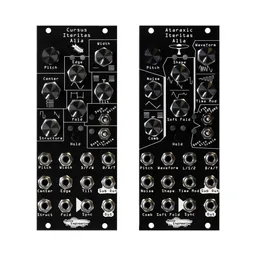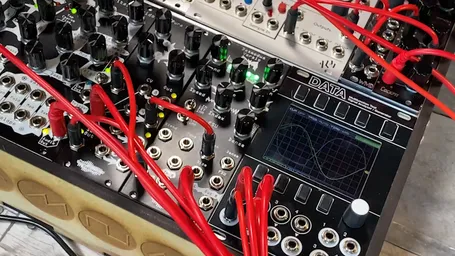Welcome back to Sound Advice, the NE advice column! Since the last episode, you all have sent us quite a few questions. So today, we’re going to answer them. Because that’s how advice columns work.
Got a question of your own? We’re all ears! Send it in here and we’ll consider it for a future episode.
Q: Can you suggest some patches using the Ataraxic Iteritas for ambient drones and soundscapes?
Gladly!
Ataraxic Iteritas is one of those modules that LOVES control voltage. Personally, I like using Pons Asinorum with its channels looping at different rates to modulate a whole bunch of AI’s parameters at once. Add a touch of reverb from something like Desmodus Versio and you’ve got a pretty sweet drone!
I’m also a big fan of independent left and right processing: mult AI’s output to, for instance, two different filters, and then patch them into the L and R inputs of Desmodus. This’ll give you some pretty intense stereo imaging, and if you modulate those filters independently you’ll get some beautiful panning effects.
Q: I wanted to know if within a sequence I can alternate the volume on specific notes. If I can’t, are there any similar tricks I can get away with? Thanks!
There’re quite a few ways to do this! The most straightforward way is by running your voice through a VCA, then modulating that VCA with a voltage sequencer like Mimetic Digitalis. Note that whenever you’re modulating the level of audio with a step sequencer, you may run into clicks and pops due to sudden level changes -- you can avoid this by running your CV through a slew limiter, if your sequencer doesn’t have one built in.
You can use other types of CV generators to modulate the VCA’s level, too, for more varied results: I’m a big fan of Clep Diaz’s random modes for creating sequenced variation in my sounds.

Mimetic Digitalis: 4-channel performable CV sequencer… and light show.
Q: I love Mimetic Digitalis but really want to swap the knob so it’s on coarse control by default. Can I do this?
Unfortunately, Mimetic Digitalis isn’t user updateable, so there’s no way to change the way that it works. When designing the MD, we had to find a balance that would work for all use cases, whether that was pitch sequencing, modulation, live performance, or something else entirely. This meant that finding the perfect knob behavior was a challenge, and that we had to make some compromises to do everything we wanted it to.
Q: I want to be able to switch Versio firmwares without removing it from the case. Why don’t you make a module to let me do that?
A: We love this idea, but if you have ever flashed your Versio, think about the procedure: there are two button presses you have to do to tell it it needs to be in the mode to learn a new firmware. Without these button presses, the flash app can’t connect, and you can’t put new firmware on the module.
We talked about doing something like this, but it generally came down to needing to install little robot hands to press the buttons for you. Which, not going to lie, sounds hella cool, but would probably end up costing a bit more than you want to pay for a 2hp USB connector.
Q: But Robot Hands….
A: No, Markus, you don’t get to ask questions in this post.
Q: Okay fine. What about one Versio that can store all the firmwares simultaneously so I can just tap a button?
A: Y’all, there are only five firmwares out there! I’m happy you’re so excited, but we’re starting to get fearful of the questions we’re going to get once more are out!
To the question though, which we have gotten from a LOT of y’all (one awesome customer even had a rad name for it: OMNI VERSIO). We think it’s a bit premature to think about this: we have a lot more to come in Versio, so it’s hard to design for something until you know how much it should hold. We’re also already at the limit of the Versio with a single firmware with many of these, so we’d need to rethink how this would work. Impossible? Probably not. But it’ll be a while before we’re really ready to full-on tackle the question.
Learn more:
Q: An amalgam of questions about Versio panels: are they available? Where, when, plastic overlays, etc., etc.
Versio panel questions are probably the category of questions we have gotten most in the last few months. So here are a few answers to the most common questions:
-
Yes, all panels are available, silver and black, in our shop and to retailers. If you are not in the US, we recommend asking a retailer to order them for you. To that end, we are also working on some better options for dealers for y’all because shipping is crazy.
-
Yes, shipping is actually $35. Even in an envelope. We have to fill out customs forms, and the base level shipping only supports shipping papers. Go above that and we’re looking at around $35 in most cases.
-
We DO have paper overlays you can print out (and the dxf if you are so inclined to make a panel yourself) at the World of Versio page on our website.
-
We have had a lot of questions about more durable overlays. We spec'd them before and they were cost prohibitive (we would have had to sell cardboard overlays for almost $10 to not lose money on the project). It seemed ludicrous, and unreasonable, so we scrapped the plan.
We have found a different potential source of more durable options, and we’re actively looking into ordering some as tests. Once we know the specs and whether they work or not, we’ll make these available for you to order directly from the source... if they work. The reality is that we don’t want you having to buy extra panels and repanel things! We would love for you to be able to slap an overlay on the module and just have it work. Our end goal is to make products that inspire you to have fun, not sit around with nut drivers and pliers trying to repanel things.
Q: Do you reverse protect your modules? What is reverse protection anyway?
Kris here. I have not been shy about telling customers who contact us with this question that we do, because if we did not, I would probably have blown up every module we own. I am the worst. Go on, judge me, it’s fine.
Reverse protection is a big deal in Eurorack. If you’re new, we have a whole post just on plugging things in. This probably seems excessive, but once you see the pile of dead modules we have between us, you’ll realize maybe it’s not.
Eurorack power connectors come in a few form factors. A keyed connector will only fit in one direction but others can easily be put on in the wrong orientation. Because of the pin layout, when this happens, you connect the -12v power to the +12v input on the module, and vice versa. Modules that do not include reverse power protection will generally not survive this (it’s also one of the several good reasons that exist to turn off the power in your case when you are rearranging your case. It gives you a little extra time to double check for mistakes!).
Reverse protecting, at its core, only requires a couple of diodes to be added to the circuit. Diodes are nifty parts that allow current to flow in only one direction. Put a diode that will allow current to flow from anode (negative) to cathode (positive) only in between the power header and the rest of the circuit, we can prevent the wrong polarity of current from flowing.

Caption: a reverse-protected power circuit. The diodes face opposite directions to allow current to flow the correct direction. If the module is plugged in backward, no current flows.
Lots of parts on modules are sensitive to overvoltage, so if you plug your module in backward without reverse protection, it’s possible to fry various components.
Q: I’ve heard that envelope generators are good for shaping an oscillator’s dynamics, but when I plug oscillator into my EG, it sounds terrible. What am I doing wrong?
Good question! This is one that I also had when I first came to modular -- in the synths I’d used before building a modular system (my Minibrute says “hi”), it seemed like the envelope generator directly controlled the volume of the oscillator. That’s actually not the case -- most analog synths use VCAs (voltage-controlled amplifiers) to control the volume of their oscillators, and the VCAs are in turn controlled by envelope generators. So if you’re struggling to create the perfect voice patch, grab a VCA!
By the way, we’ll be discussing envelopes and VCAs in the next episode of our Getting Started series, too. Stay tuned!
And with that, another round of questions are answered. Don’t forget to send in your burning inquiries for the next edition!






